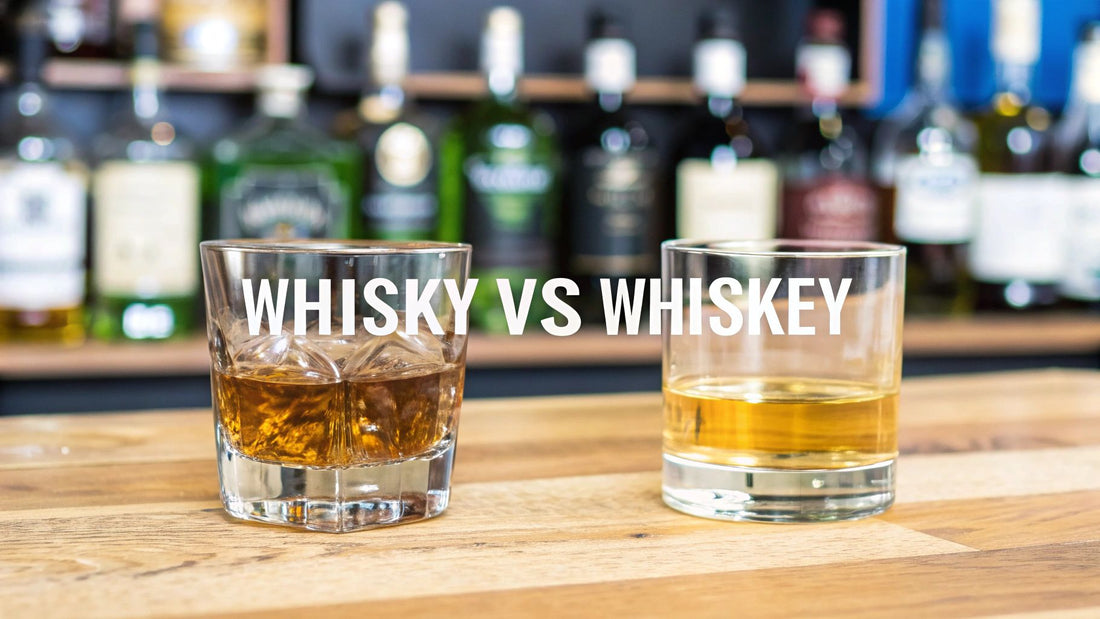At its core, the difference between whisky and whiskey boils down to one simple thing: geography. That extra "e" isn't just a typo; it’s a tiny detail that tells a huge story about where the spirit was born.
As a rule of thumb, whiskey with an 'e' comes from the United States and Ireland. On the other hand, whisky without the 'e' is the spelling you'll see on bottles from Scotland, Canada, and Japan.
Your Quick Guide to the Main Difference
Getting a handle on the whisk(e)y spelling is your first step into a much larger, more fascinating world. While that one letter is the most obvious clue, it points to deeper divides in production methods, ingredients, and ultimately, the flavors that define each style. This split is about more than just grammar—it's a nod to history, tradition, and a healthy dose of national pride.
This spelling divide really took hold back in the late 19th century. As distilleries started shipping their spirits globally, they needed a way to stand out in a crowded market, and a simple change in spelling became a mark of origin and identity. This practice has stuck around ever since, defining the industry as we know it today. You can get lost in the full history of the spirit on Wikipedia to see just how it all unfolded.
A Visual Breakdown
This infographic lays it all out, giving you a clean, at-a-glance comparison of what that 'e' really means.
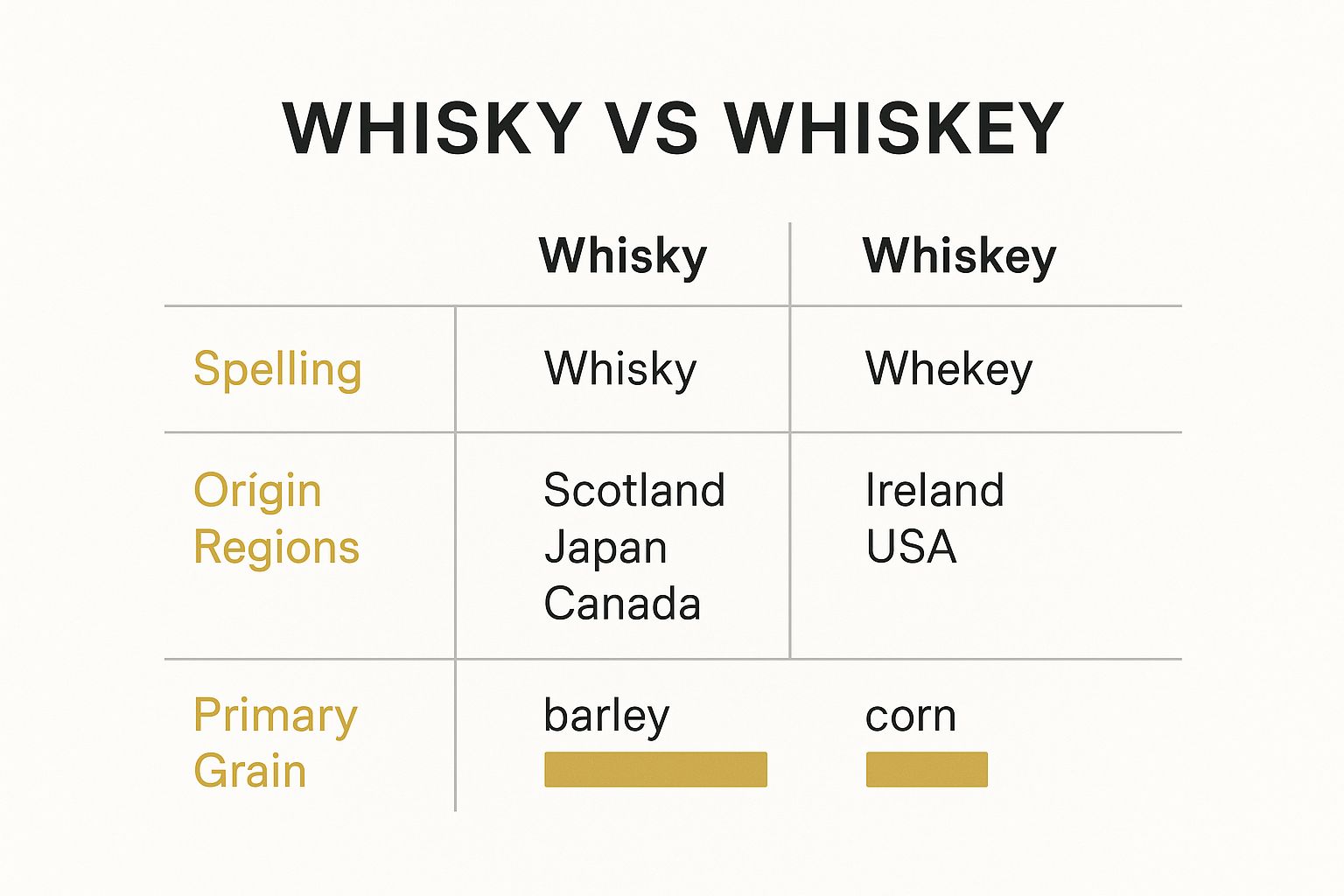
As the chart shows, where a spirit comes from doesn't just dictate its name. It directly influences the primary grains used in the mash, which is the foundational building block of its final taste profile.
At-a-Glance Comparison: Whisky and Whiskey Styles
To dig a bit deeper, this table breaks down the key characteristics across the world's major whisk(e)y styles. Think of it as your cheat sheet for navigating the vast world of brown spirits.
| Characteristic | Scotch Whisky | Irish Whiskey | American Whiskey (Bourbon) | Japanese Whisky |
|---|---|---|---|---|
| Spelling | Whisky | Whiskey | Whiskey | Whisky |
| Origin | Scotland | Ireland | United States | Japan |
| Primary Grain | Malted Barley | Barley (malted & unmalted) | Corn (at least 51%) | Malted Barley |
| Typical Flavor | Smoky, peaty, floral | Smooth, light, fruity | Sweet, caramel, vanilla | Balanced, floral, delicate |
This is especially helpful for new drinkers trying to map out their tasting journey. For instance, you’ll immediately notice how a corn-heavy American whiskey, like one from a craft brand such as FEW Spirits, delivers a signature sweetness that stands in stark contrast to the earthy, malt-forward character of a classic Scotch.
How History Forged the Spelling Divide
That extra 'e' in whiskey isn't just some random quirk of grammar. It’s a battle scar from the fierce market wars of the 19th century, a deliberate line drawn in the sand between Ireland and Scotland as each nation fought for control of the global spirits trade.
As Irish distillers perfected their craft, they needed a way to signal to the world that their spirit was different—and, in their eyes, superior. Their solution was simple but brilliant: just add an 'e'. This tiny change became a powerful marketing tool, a clear signal to drinkers that Irish whiskey was a smoother, often triple-distilled spirit, distinct from the more common double-distilled Scotch whiskies of the time. This was no accident; it was a calculated move to own the premium shelf.
Economic Pressures and Clever Innovation
But this story is about more than just slick marketing. It was also forged by economic necessity. Back in the 18th century, a hefty British tax hike on malted barley put Irish distillers in a tough spot. To protect their bottom line, they got creative.
Their answer was to mix unmalted barley and other grains into their mash bills. This move not only slashed their tax bill but also unintentionally created a uniquely spicy, creamy, and full-bodied spirit that we now know as 'pot still' Irish whiskey. This innovative spirit proved to be a massive hit. You can get a deeper dive into this pivotal moment in whisky's history on lakesdistillery.com.
This clever workaround gave Irish producers a huge leg up on their Scottish rivals, who mostly stuck with the more heavily taxed all-malted barley mash. The result? A spirit that was both cheaper to make and wildly popular for its signature taste.
Key Insight: The spelling difference is a direct legacy of economic strategy. Irish distillers used the 'e' to differentiate their smoother, innovative pot-still spirit from the competition, turning a tax loophole into a signature style.
And as Irish whiskey started hitting its stride, a disaster across the English Channel created the opportunity of a lifetime.
A Perfect Storm for Irish Whiskey
In the 1860s, the phylloxera louse swept through Europe's vineyards, absolutely decimating French wine and brandy production. Suddenly, the world's favorite aged spirit was gone, leaving a massive hole in the market.
Irish distillers, with their large-scale operations and a product people already loved, were perfectly positioned to step in and fill that void.
This perfect storm—a savvy response to taxes, a unique and desirable product, and the sudden collapse of a major competitor—catapulted Irish whiskey to become the most popular spirit in the world by the late 19th century. The 'e' in whiskey became a symbol of this global success, cementing its place in our vocabulary. This history is crucial to understanding that the difference between whisky and whiskey is so much more than just a letter.
Exploring the World of Whisky Without an E
Now, let's venture into the world of whisky—spelled without the 'e'. This is the territory of Scotland, Japan, and Canada, where each nation has cultivated a distinct philosophy around its national spirit. The result is a spectrum of flavors that stands in sharp contrast to its "whiskey" cousins.
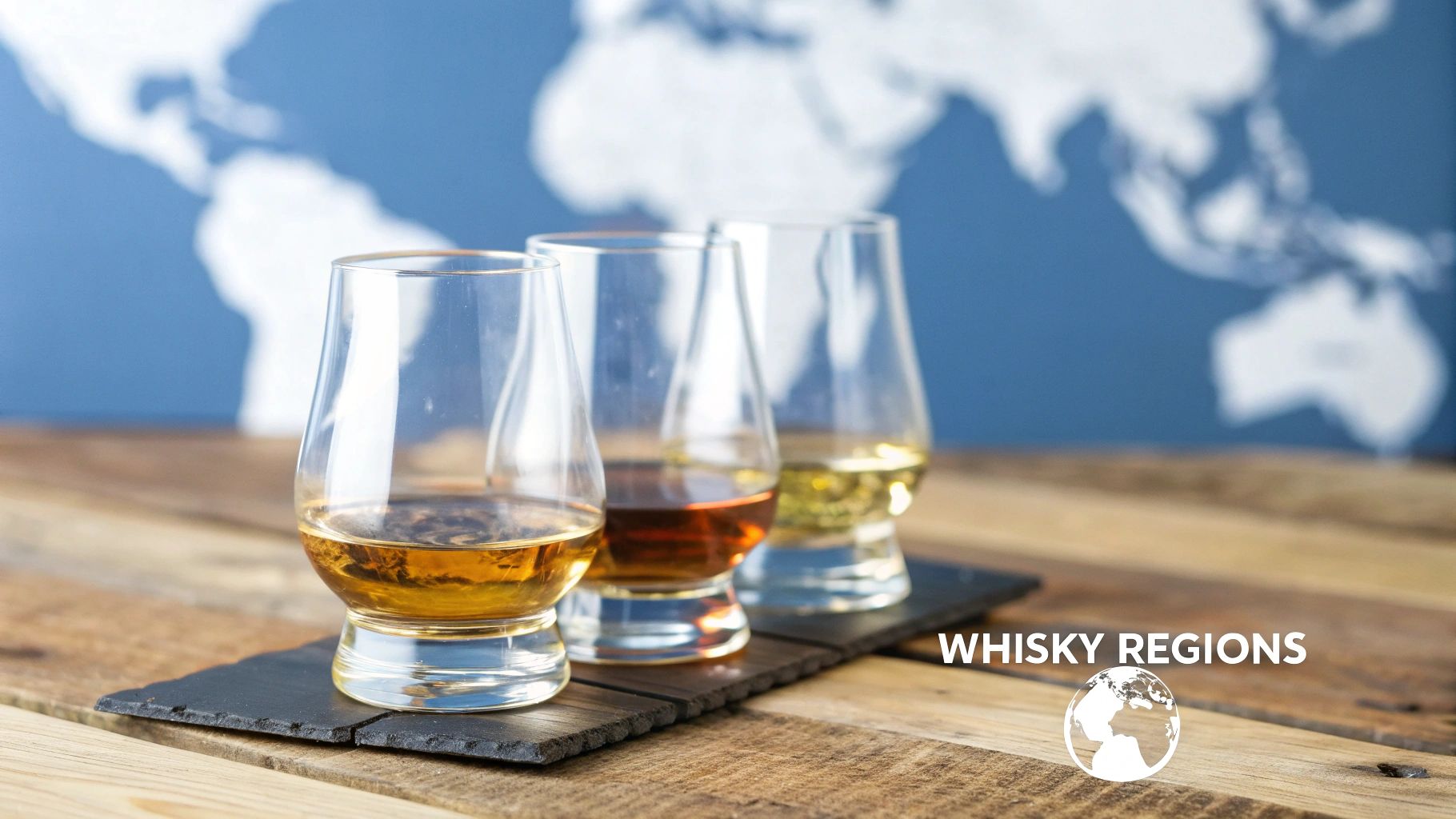
Understanding these regional identities is about more than just geography. It’s about how terroir, deep-rooted tradition, and specific techniques come together to shape every single drop. From the windswept coasts of Scotland to the meticulously run distilleries of Japan, the approach is as varied as the landscapes themselves.
Scotland: The Original Whisky Pioneer
Scotland is the undisputed heartland of whisky. For many, it's a country whose very identity is intertwined with its spirit. Scotland is divided into several iconic whisky-producing regions, each boasting its own signature style.
- Speyside: If you're looking for elegant, fruity, and often sweet profiles, Speyside is your destination. It's home to giants like Glenfiddich and The Macallan, making their whiskies a perfect entry point for anyone new to Scotch.
- Islay: Known for its powerfully smoky and peated whiskies, Isay delivers a bold, maritime character. Brands like Laphroaig and Ardbeg are legendary for intense, almost medicinal notes that come from drying barley over peat fires.
That "peaty" flavor is a defining characteristic for many Scotch whiskies. To really get a handle on it, you can check out our guide on what peaty Scotch is, which breaks down exactly how this unique flavor profile is created.
Japan: A Quest for Harmony and Precision
Japanese whisky production kicked off in the 1920s, with its pioneers drawing direct inspiration from Scottish methods. Masataka Taketsuru, a founding father of the industry, actually studied distillation in Scotland and brought that knowledge back home.
But Japanese whisky is no mere copy. It is a masterful reinterpretation built on the pillars of balance, harmony, and an obsessive pursuit of perfection.
Distilleries like Yamazaki and Nikka are celebrated for producing whiskies of incredible elegance and complexity. A single distillery will often create a wide variety of spirit styles, giving their blenders a massive palette to work from. This results in meticulously balanced whiskies with subtle floral, fruit, and gentle smoke notes.
For the new drinker, a Japanese whisky like Suntory Toki is an excellent introduction. It's light, versatile, and showcases the signature Japanese pursuit of a clean, refined flavor profile that works beautifully on its own or in a highball.
Canada: The Master of Smoothness
Canadian whisky has long been defined by its smoothness and approachability. For years, its reputation was built on light, rye-forward blends that were incredibly easy to mix in cocktails. This reputation for being exceptionally smooth isn't an accident; it comes from a unique production process.
Canadian distillers often ferment, distill, and age different grains—like corn, rye, and barley—completely separately. Only after these individual spirits have matured do they blend them together to achieve a precise and consistent flavor. It’s this method that gives brands like Crown Royal their famously smooth character.
While the classics are known for being lighter, many Canadian distilleries are now crafting bolder, 100% rye whiskies that deliver a lot more spice and complexity, capturing the attention of a whole new generation of drinkers.
Discovering American and Irish Whiskey with an E
When you see a spirit spelled with that extra "e," you're stepping into the worlds of Ireland and the United States—two countries that have left a massive mark on the global whiskey landscape. While they share the spelling, that's often where the similarities end. Their production methods, legal definitions, and flavor profiles offer entirely different experiences for drinkers of all stripes.
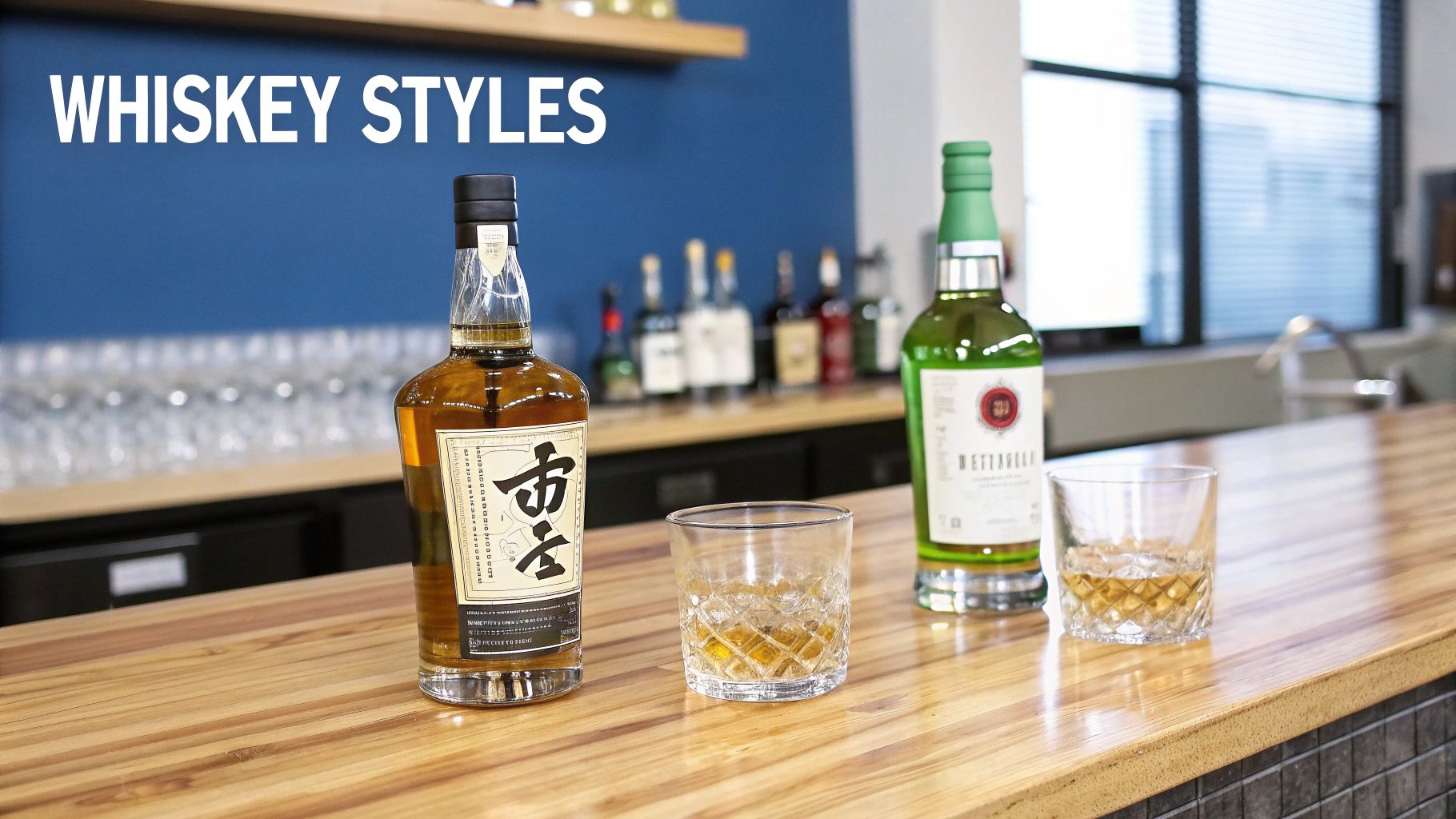
This side of the aisle is all about approachability and innovation. From the famously smooth, triple-distilled spirits of Ireland to America's bold, grain-forward styles, "whiskey" offers a dynamic and diverse range perfect for exploration.
The American Whiskey Tradition
American whiskey is a story of rebellion, resourcefulness, and—eventually—strict legal standards. Its identity was forged in the early days of the nation, as distillers, many of them Irish and Scottish immigrants, adapted their craft to the New World's abundant grains. Corn, in particular, became the cornerstone of America's most famous spirit.
This history wasn't always a smooth pour. The Whiskey Rebellion of 1794 was a critical flashpoint where farmers violently protested a new federal tax on spirits. This event didn't just test the young government's authority; it drove home just how deeply whiskey was woven into the cultural and economic fabric of early America. You can get the full story on this historic uprising and its impact on American whiskey at fivetownswines.com.
Today, American whiskey is governed by some pretty specific rules that define its character:
- Bourbon: Has to be made from a mash bill of at least 51% corn, which gives it that signature sweetness with notes of caramel and vanilla. It also has to be aged in new, charred oak barrels—no reusing barrels here—which imparts deep color and rich flavor.
- Rye: Must contain at least 51% rye in its mash bill. This grain gives it a spicier, more assertive flavor profile, often packed with notes of pepper, baking spices, and a bit of fruit.
Tip for New Drinkers: If you're just starting your journey, a wheated Bourbon is a fantastic entry point. Swapping some rye for wheat in the recipe softens the spirit, creating a gentler, sweeter profile compared to the spice-forward, high-rye Bourbons.
American Craft Brands Redefining the Rules
While tradition is one thing, the American craft whiskey movement is where the real excitement is right now. Small, independent distilleries are pushing boundaries left and right with unique grains, experimental aging techniques, and a laser focus on local ingredients.
Brands like Stranahan's in Colorado are pioneering the American Single Malt category, using 100% malted barley to create complex and robust profiles that stand up to their Scottish cousins. Out in Utah, High West Distillery is celebrated for its masterful blending and unique finishes, creating whiskeys that are both familiar and entirely new. Digging into these craft brands is the best way to see the creative spirit of American whiskey in action.
Irish Whiskey: The King of Smoothness
Irish whiskey's claim to fame has always been its exceptional smoothness, a quality that comes down to its signature triple-distillation process. While most Scottish distilleries distill twice, that third run in Ireland helps strip out more impurities, resulting in a lighter, cleaner, and incredibly approachable spirit.
This smoothness makes Irish whiskey a true workhorse. It’s perfect for sipping neat, but it also shines in cocktails where it plays well with other ingredients instead of overpowering them. Brands like Jameson and Bushmills are the classic introduction, but the category also boasts the unique "Single Pot Still" style—a creamy, spicy whiskey made from a mix of both malted and unmalted barley that you can only find in Ireland.
How Production Methods Define Flavor Profiles
Forget geography and spelling for a moment. The real story behind whisky and whiskey is told in how they're made. Every single choice—from the grains in the mash to the shape of the still and the life of the barrel—leaves a distinct fingerprint on the spirit in your glass. Nailing these details is the key to understanding why you gravitate towards certain styles over others.
It all starts with the mash bill, which is just the distiller's grain recipe. For a spirit to legally be called Bourbon, it needs a mash bill of at least 51% corn. This is where Bourbon gets its signature sweetness and those classic notes of vanilla and caramel. It’s what gives many American craft whiskeys, like the bold spirits from Texas distillery Balcones, their rich, approachable character.
Scotch single malts, on the other hand, are purists. They're made from 100% malted barley. In regions like Islay, distillers take it a step further by drying that barley over burning peat, which infuses the grain with an intense smoky, medicinal punch that is unmistakably Scottish.
From Still to Spirit
The next major fork in the road is distillation. Irish distillers are famous for their triple distillation process. This extra step strips out more impurities, resulting in an exceptionally smooth, light-bodied spirit. It’s exactly why brands like Jameson have built a reputation for being so easy-drinking.
Most other whiskies, including Scotch and Bourbon, are typically distilled twice. The equipment used here is also a massive factor. Traditional copper pot stills tend to create a fuller, richer spirit, while modern column stills yield a lighter, cleaner one. To really get into the weeds on how these work, you can explore the art of whiskey distillation and see how each method crafts a unique spirit from the ground up.
Tennessee Whiskey, a distinct category of American whiskey, adds a unique filtration step known as the Lincoln County Process. Before barreling, the new-make spirit is slowly dripped through sugar maple charcoal. This extra touch mellows the whiskey, sanding off any rough edges and adding a subtle smoky sweetness.
The Final Touch: Maturation
Finally, we arrive at maturation, the long sleep in wooden casks where a massive portion of the flavor is born. By law, Bourbon must be aged in new, charred American oak barrels. This process imparts intense flavors of caramel, vanilla, and spice. Because these barrels can only be used once for Bourbon, they often find a second life across the pond.
Scotch and Irish whiskies are frequently aged in these used ex-Bourbon barrels, which lend softer, more subtle notes. Producers in Scotland and Ireland also commonly use ex-sherry or wine casks to layer in complex fruity, nutty, and spicy characteristics. This fundamental difference in wood management is a huge reason why a 12-year-old Scotch tastes worlds apart from a 12-year-old American whiskey. Each step isn't just a part of a process; it's a deliberate choice that defines the spirit's soul.
To put it all together, let’s look at how these production stages directly shape the final product across major styles.
Comparing Production and Flavor Impact
| Production Stage | Scotch Whisky | Irish Whiskey | American Bourbon |
|---|---|---|---|
| Primary Grain | 100% Malted Barley (for single malts), creating earthy, cereal notes. Peat is often used for smoky flavors. | Malted and unmalted barley, contributing a spicy, grainy character. | Minimum 51% Corn, which provides a distinct sweetness with vanilla and caramel notes. |
| Distillation | Typically double-distilled in copper pot stills, resulting in a rich, complex, and full-bodied spirit. | Traditionally triple-distilled, leading to a much smoother, lighter, and cleaner profile. | Usually double-distilled using a mix of column and pot stills, creating a robust but clean spirit. |
| Maturation Casks | Aged in used casks, most commonly ex-Bourbon, but also ex-sherry, port, or wine casks for added complexity. | Primarily aged in used ex-Bourbon barrels, though sherry and other fortified wine casks are also used. | Must be aged in new, charred American oak barrels, imparting strong vanilla, caramel, and spice flavors. |
As you can see, from the initial grain selection to the final maturation, every decision is a building block for the final flavor profile. No single element works in isolation; it’s the combination of these techniques that gives each whiskey its unique identity.
Your Guide to Tasting and Finding Your Favorite
Diving into the world of whisk(e)y is really an adventure for your senses. The trick is simply learning how to taste it properly. Once you get the hang of it, you’ll start to appreciate the subtle dance between a smoky Scotch whisky and a sweet American whiskey. This isn't about becoming an expert overnight; it's about paying attention to what you actually enjoy.
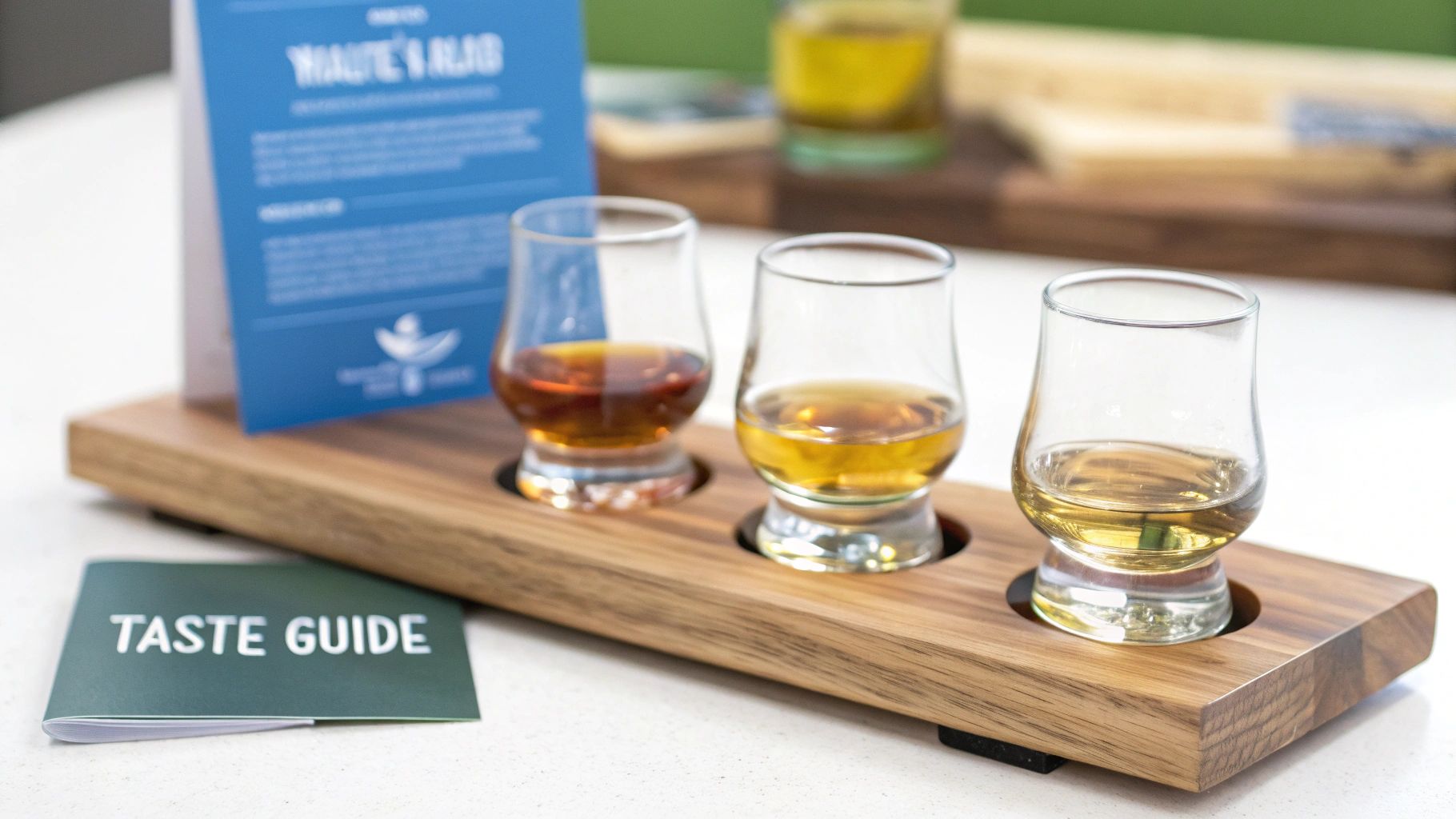
The whole process is much simpler than it sounds. It really starts before you even take a sip, beginning with the aromas swirling in the glass. To properly explore this, you can learn more about how to taste whiskey in our detailed guide. We cover everything from the right glassware to identifying those specific flavor notes.
How to Approach a New Dram
A structured approach is your best friend when trying to identify the unique character of each spirit. Think of it as a three-part journey that engages your nose, palate, and senses to decode the story in your glass.
- Nosing: Gently swirl the glass and bring it toward your nose, keeping your mouth just slightly open. Breathe in and see what you pick up. Are the first aromas sweet like caramel, fruity like crisp apples, or smoky like a distant campfire?
- Tasting: Take a small sip and let it coat your entire tongue. What are the primary flavors hitting you? Is it sweet and creamy, or does it have a spicy, bold kick? Pay attention to the texture, what we call the "mouthfeel"—is it light and delicate or rich and oily?
- Finishing: After you swallow, notice the taste that lingers. This is the finish. Does it fade away quickly, or does a warm, spicy sensation stick around? A long, pleasant finish is almost always the sign of a well-crafted spirit.
Pro Tip for New Drinkers: Add just a few drops of water to your whiskey. This little trick can "open up" the spirit by lowering the alcohol proof just enough, making it much easier to detect subtle aromas and flavors that might otherwise be hiding.
Building Your First Tasting Flight
Honestly, the best way to truly understand the difference between whisky and whiskey is to taste them side-by-side. A beginner’s flight is perfect for this, as it highlights the core characteristics of the major styles without completely overwhelming your palate.
Start with these accessible and classic bottles:
- Scotch Whisky: Glenfiddich 12 is a fantastic entry point. It offers a classic Speyside profile with clean notes of pear and a light, floral character.
- Irish Whiskey: Jameson is a perfect example of the smooth, fruity, and approachable nature of triple-distilled Irish whiskey.
- American Whiskey: Maker's Mark, a wheated bourbon, delivers that signature sweetness with unmistakable notes of vanilla and caramel.
Tasting these three together gives you a clear, real-world lesson in how grain, distillation, and maturation create wildly different spirits. From this starting point, you can begin exploring exciting American craft whiskey brands like Westward Whiskey or FEW Spirits to see how modern distillers are really pushing the creative boundaries.
A Few Common Questions About Whisky and Whiskey
As you dive into the world of whisky (and whiskey), a few questions pop up time and time again. Let's clear the air on some of the most common ones so you can feel more confident, whether you're scanning a bar menu or the aisle at your local shop.
The main thing to remember is that the difference between whisky and whiskey is all about where it's from, not how good it is.
Does Adding an 'E' Make Whiskey Better Than Whisky?
Nope. The spelling is simply a nod to the country of origin and has absolutely zero to do with quality. Both whisky from places like Scotland and Japan and whiskey from the US and Ireland produce a massive spectrum of styles, from simple, everyday mixers to absolutely world-class spirits.
What truly makes a spirit exceptional comes down to the quality of its ingredients, the skill of the distiller, and the time it spends maturing—not the letters on the label.
What Is the Best Type of Whiskey for a Beginner?
For anyone just starting out, smooth and approachable styles are the way to go. The triple-distillation process common in Irish whiskeys often results in a mellow, easy-drinking spirit, making it a fantastic first choice for many.
If you're curious about American whiskey, a "wheated" Bourbon is a great entry point. Distillers like Maker's Mark use wheat instead of rye as the secondary grain, which dials down the spice and amps up the soft, sweet notes. It's an incredibly welcoming dram and a perfect gateway to exploring the bolder world of American craft whiskeys.
Can I Use Scotch in a Cocktail Like an Old Fashioned?
Absolutely! While Bourbon or Rye are the classic workhorses for an Old Fashioned, swapping in Scotch can create a phenomenal variation. A good blended Scotch or a lighter, fruit-forward Speyside single malt will play beautifully with the sugar and bitters without overwhelming the drink.
And if you're feeling a bit more adventurous, try making one with a lightly peated Scotch. That subtle wisp of smoke introduces an incredible new dimension to a timeless cocktail. Don't ever be afraid to experiment—it's how you'll find what you truly love.
Ready to figure out what your palate really prefers, free from any bias? Blind Barrels sends you quarterly tasting kits filled with top-shelf American craft whiskeys, letting your taste buds do all the talking.
Explore our blind tasting experience at https://www.blindbarrels.com.
